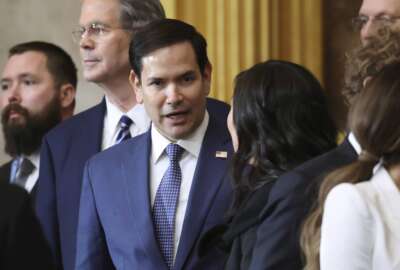COVID-19 has presented an enormous challenge to the military’s contracting community. Like most of the rest of us, the vast majority of the acquisition workforce had to adapt to a full-time telework environment almost overnight.
They did that while adding something of an emergency responder role to their day-to-day jobs, accelerating contract payments toward companies in danger of collapse, and in the case of the Air Force, serving as the executive agent for the Defense Production Act. To buy millions of items of personal protective equipment and other needs that arose from the coronavirus emergency, they also needed to learn the ins-and-outs of an industry – health care – that most of the military’s contracting community doesn’t work with on a regular basis.
Fortunately, when it came to the need to be agile and flexible, the Air Force’s contracting workforce hit the ground running when the pandemic struck, according to Maj. Gen. Cameron Holt, the deputy assistant secretary of the Air Force for contracting.
“In Air Force contracting, we’ve been on a tear – a revolution, so to speak – called Mission-Focused Business Leadership, where we’ve taken a ton of actions to push authorities down and kill all of the rules that don’t make any sense,” Holt said. “We’ve been trying to inspire some of our young folks take risks, to innovate, understand the mission, and find the best ways forward without fearing the D.C. recrimination culture.”
That process was well underway before the pandemic – though the main motivation was to ensure the contracting workforce was ready to tackle an era of great power competition.
As part of that process – which included hour-long briefings on military threats for leaders throughout the contracting workforce – Holt also delegated many of the Air Force’s key approval authorities downward, doubling the authority of lower-level leaders in each mission area to approve contracts.
And he said he’s done all he can along the way to make sure that devolution is as permanent as it can be.
“If you’re doing this for show, it’s very simple to push authority down and sound very innovative and forward-leaning. But if you really want it to endure, it’s a lot of hard work, because you’ve got to be willing to burn what you’re not going to use anymore,” Holt said. “I joke with my folks that I am Cortés, and I am burning the ships behind us. We are not going back. Not only did we delete hundreds of pages of useless, mandatory procedures that really just served to stop people from thinking, but we streamlined what remained. And we did the hard work to actually write that down.”
And the COVID-19 pandemic presented a near-perfect test case to determine if the Defense acquisition bureaucracy can move in a streamlined fashion, especially when it really needs to. Throughout the emergency, the contracting workforce has been as productive as ever – obligation rates have gone up, not down.
That agility has been apparent even from outside the acquisition bureaucracy, said Michael Weaver, the vice president of product management at PROPRICER, a firm that develops pricing software for both federal agencies and contractors.
“I think part of it comes from the Cloud Smart policy and their ability to adapt to remote work very quickly…on the federal government side, it was very turnkey for them to start working remotely much faster than we all expected,” he said. “Thinking about how we can make those things readily available, highly-deliverable, and shorten the amount of time it takes for people to come up to speed on the product have been major focuses for us. So it’s been really nice to see that when things like COVID happen, it really doesn’t hurt as much as you’d expect it to.”
Contracting Policy and the Pandemic
In Air Force contracting, we’ve been on a tear – a revolution, so to speak – called Mission-Focused Business Leadership, where we’ve taken a ton of actions to push authorities down and kill all of the rules that don’t make any sense. We’ve been trying to inspire some of our young folks take risks, to innovate, understand the mission, and find the best ways forward without fearing the D.C. recrimination culture.
Maj. Gen. Cameron Holt
Deputy Assistant Secretary, Contracting, Air Force
If you’re doing this for show, it’s very simple to push authority down and sound very innovative and forward-leaning. But if you really want it to endure, it’s a lot of hard work, because you’ve got to be willing to burn what you’re not going to use anymore. I joke with my folks that I am Cortés, and I am burning the ships behind us. We are not going back. Not only did we delete hundreds of pages of useless, mandatory procedures that really just served to stop people from thinking, but we streamlined what remained. And we did the hard work to actually write that down.
Maj. Gen. Cameron Holt
Deputy Assistant Secretary, Contracting, Air Force
Government’s Adaptation to Telework
I think part of it comes from the Cloud Smart policy and their ability to adapt to remote work very quickly…on the federal government side, it was very turnkey for them to start working remotely much faster than we all expected, Thinking about how we can make those things readily available, highly-deliverable, and shorten the amount of time it takes for people to come up to speed on the product have been major focuses for us. So it’s been really nice to see that when things like COVID happen, it really doesn’t hurt as much as you’d expect it to.
Michael Weaver
Product Innovation Director, PROPRICER
What we're seeing now is, if industry has in issue, we're sharing that with our government customers. If they have an issue, they're sharing it with us so we can get to solutions quicker and faster.
George Barbic
Director of Estimating, Program Assessment and Evaluation, Lockheed Martin Corporation
Listen to the full show:
Copyright
© 2025 Federal News Network. All rights reserved. This website is not intended for users located within the European Economic Area.












